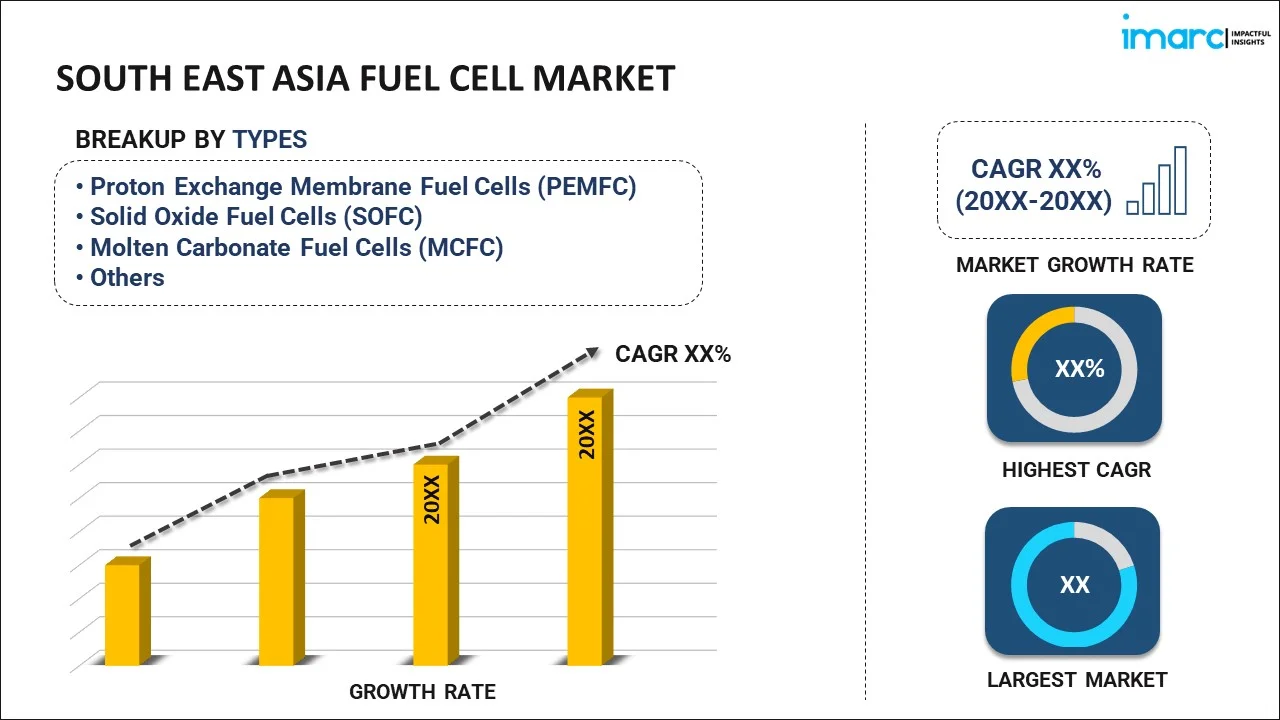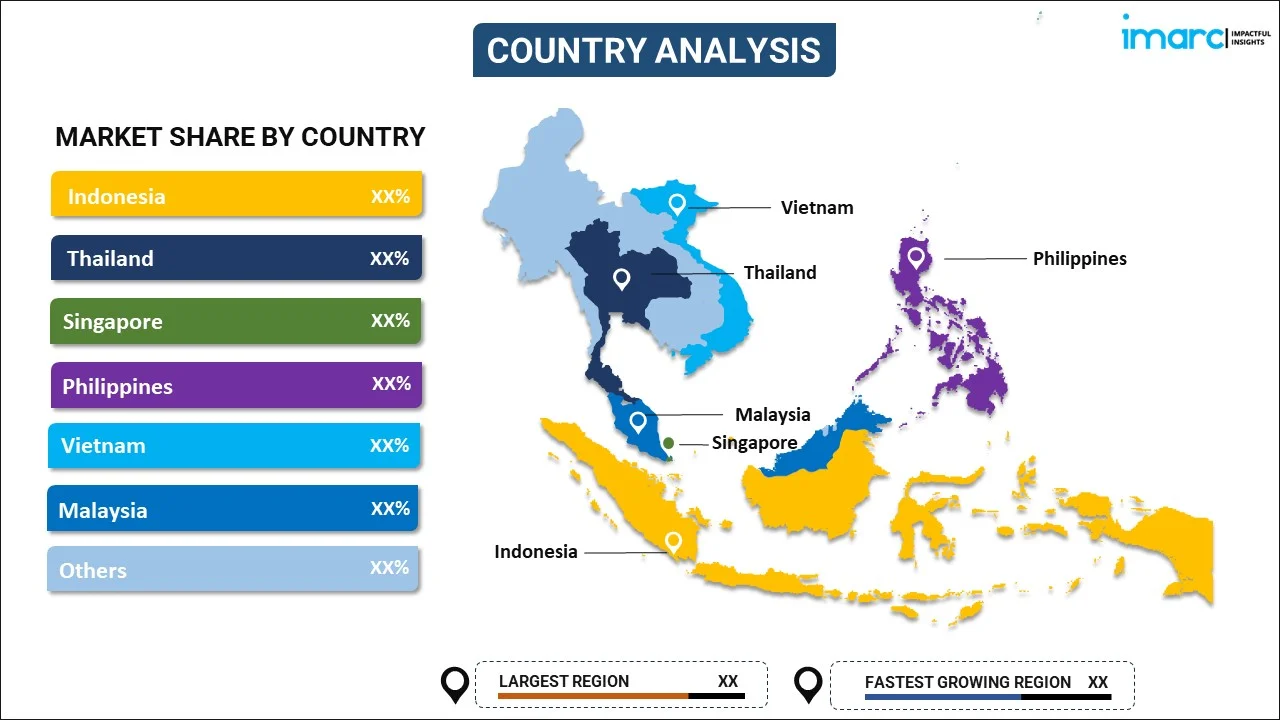
South East Asia Fuel Cell Market Report by Type (Proton Exchange Membrane Fuel Cells (PEMFC), Solid Oxide Fuel Cells (SOFC), Molten Carbonate Fuel Cells (MCFC), Direct Methanol Fuel Cells (DMFC), Phosphoric Acid Fuel Cells (PAFC), and Others), Application (Stationary, Transportation, Portable), and Country 2024-2032
Market Overview:
The South East Asia fuel cell market size is projected to exhibit a growth rate (CAGR) of 32.69% during 2024-2032. The growing environmental awareness and concerns about air pollution, increasing collaborations between governments, industries, and research institutions, and the rising product adoption in the transportation sector represent some of the key factors driving the market.
|
Report Attribute
|
Key Statistics
|
|---|---|
|
Base Year
|
2023 |
|
Forecast Years
|
2024-2032
|
|
Historical Years
|
2018-2023
|
| Market Growth Rate (2024-2032) | 32.69% |
A fuel cell is an electrochemical device that converts chemical energy from a fuel and an oxidizing agent (usually hydrogen and oxygen) into electrical energy, heat, and water. It operates on the principle of an electrochemical reaction occurring at two electrodes, an anode (negative electrode) and a cathode (positive electrode), with an electrolyte in between. Fuel cells have high energy conversion efficiency, often exceeding that of traditional combustion-based power generation. They can achieve efficiency levels of 60% to 80%, resulting in less wasted energy. They operate quietly and produce minimal vibration compared to internal combustion engines, making them suitable for various applications. Besides, fuel cells can be used in a wide range of applications, including transportation (such as fuel cell vehicles), stationary power generation (for homes and businesses), backup power systems, and more. They are considered a promising technology for addressing energy and environmental challenges, particularly in the transition toward cleaner and more sustainable energy sources.
South East Asia Fuel Cell Market Trends:
The growing environmental awareness and concerns about air pollution and climate change are driving interest in clean and sustainable energy solutions. Fuel cells are considered environmentally friendly because they produce electricity with no harmful emissions, contributing to a reduction in greenhouse gases. In addition, many Southeast Asian governments are implementing policies, incentives, and subsidies to promote the adoption of clean energy technologies, including fuel cells. These initiatives encourage businesses and consumers to invest in fuel cell systems. Besides, the region's increasing energy demands and the need for energy security are prompting governments and businesses to explore alternative energy sources. Fuel cells offer a reliable and resilient source of electricity, particularly in remote or off-grid areas. Moreover, the Southeast Asian region is experiencing rapid urbanization and industrialization. This growth leads to increased energy consumption. Fuel cells can provide distributed power generation solutions for urban and industrial applications, reducing the strain on centralized power grids. Additionally, collaboration between governments, industries, and research institutions is fostering the development and deployment of fuel cell technologies. Joint projects and partnerships are accelerating the adoption of fuel cells across various sectors. Furthermore, the transportation sector in Southeast Asia is exploring fuel cell technology for clean and efficient mobility solutions. Fuel cell vehicles (FCVs) are gaining traction to reduce greenhouse gas emissions in the transportation industry. Besides this, Southeast Asian countries are investing in hydrogen infrastructure to support fuel cell adoption as the development of hydrogen infrastructure, including hydrogen production, storage, and distribution, is crucial for the growth of the fuel cell market.
South East Asia Fuel Cell Market Segmentation:
IMARC Group provides an analysis of the key trends in each segment of the market, along with forecasts at the regional and country levels for 2024-2032. Our report has categorized the market based on type and application.
Type Insights:

- Proton Exchange Membrane Fuel Cells (PEMFC)
- Solid Oxide Fuel Cells (SOFC)
- Molten Carbonate Fuel Cells (MCFC)
- Direct Methanol Fuel Cells (DMFC)
- Phosphoric Acid Fuel Cells (PAFC)
- Others
The report has provided a detailed breakup and analysis of the market based on the type. This includes proton exchange membrane fuel cells (PEMFC), solid oxide fuel cells (SOFC), molten carbonate fuel cells (MCFC), direct methanol fuel cells (DMFC), phosphoric acid fuel cells (PAFC), and others.
Application Insights:
- Stationary
- Transportation
- Portable
A detailed breakup and analysis of the market based on the application have also been provided in the report. This includes stationary, transportation, and portable.
Country Insights:

- Indonesia
- Thailand
- Singapore
- Philippines
- Vietnam
- Malaysia
- Others
The report has also provided a comprehensive analysis of all the major regional markets, which include Indonesia, Thailand, Singapore, Philippines, Vietnam, Malaysia, and Others.
Competitive Landscape:
The market research report has also provided a comprehensive analysis of the competitive landscape. Competitive analysis such as market structure, key player positioning, top winning strategies, competitive dashboard, and company evaluation quadrant has been covered in the report. Also, detailed profiles of all major companies have been provided.
South East Asia Fuel Cell Market Report Coverage:
| Report Features | Details |
|---|---|
| Base Year of the Analysis | 2023 |
| Historical Period | 2018-2023 |
| Forecast Period | 2024-2032 |
| Units | US$ Million |
| Scope of the Report | Exploration of Historical and Forecast Trends, Industry Catalysts and Challenges, Segment-Wise Historical and Predictive Market Assessment:
|
| Types Covered | Proton Exchange Membrane Fuel Cells (PEMFC), Solid Oxide Fuel Cells (SOFC), Molten Carbonate Fuel Cells (MCFC), Direct Methanol Fuel Cells (DMFC), Phosphoric Acid Fuel Cells (PAFC), Others |
| Applications Covered | Stationary, Transportation, Portable |
| Countries Covered | Indonesia, Thailand, Singapore, Philippines, Vietnam, Malaysia, Others |
| Customization Scope | 10% Free Customization |
| Report Price and Purchase Option | Single User License: US$ 3699 Five User License: US$ 4699 Corporate License: US$ 5699 |
| Post-Sale Analyst Support | 10-12 Weeks |
| Delivery Format | PDF and Excel through Email (We can also provide the editable version of the report in PPT/Word format on special request) |
Key Questions Answered in This Report:
- How has the South East Asia fuel cell market performed so far and how will it perform in the coming years?
- What has been the impact of COVID-19 on the South East Asia fuel cell market?
- What is the breakup of the South East Asia fuel cell market on the basis of type?
- What is the breakup of the South East Asia fuel cell market on the basis of application?
- What are the various stages in the value chain of the South East Asia fuel cell market?
- What are the key driving factors and challenges in the South East Asia fuel cell?
- What is the structure of the South East Asia fuel cell market and who are the key players?
- What is the degree of competition in the South East Asia fuel cell market?
Key Benefits for Stakeholders:
- IMARC’s industry report offers a comprehensive quantitative analysis of various market segments, historical and current market trends, market forecasts, and dynamics of the South East Asia fuel cell market from 2018-2032.
- The research report provides the latest information the market drivers, challenges, and opportunities in the South East Asia fuel cell market.
- Porter's five forces analysis assist stakeholders in assessing the impact of new entrants, competitive rivalry, supplier power, buyer power, and the threat of substitution. It helps stakeholders to analyze the level of competition within the South East Asia fuel cell industry and its attractiveness.
- Competitive landscape allows stakeholders to understand their competitive environment and provides an insight into the current positions of key players in the market.
Need more help?
- Speak to our experienced analysts for insights on the current market scenarios.
- Include additional segments and countries to customize the report as per your requirement.
- Gain an unparalleled competitive advantage in your domain by understanding how to utilize the report and positively impacting your operations and revenue.
- For further assistance, please connect with our analysts.
 Inquire Before Buying
Inquire Before Buying
 Speak to an Analyst
Speak to an Analyst
 Request Brochure
Request Brochure
 Request Customization
Request Customization




.webp)




.webp)












